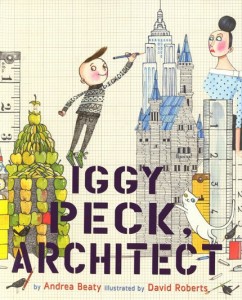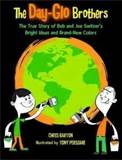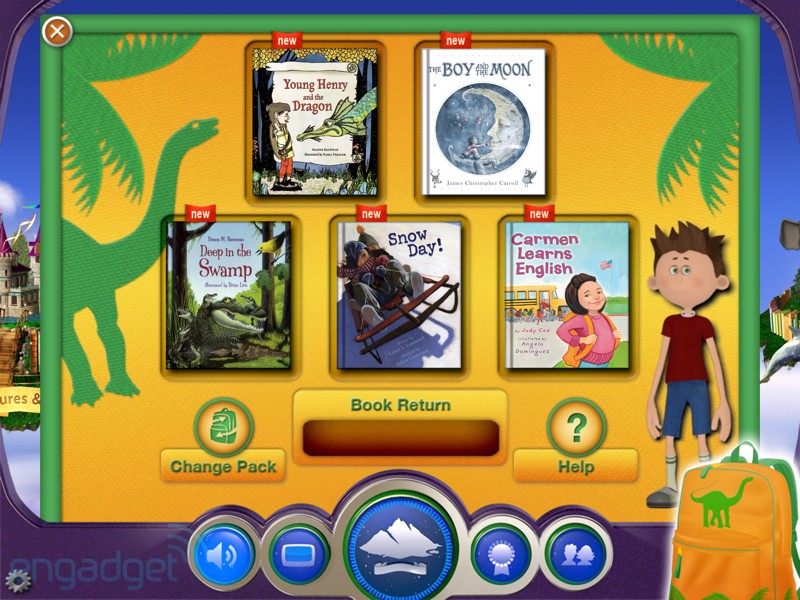Body Actions
 There seems to be a direct correlation between the amount of days left in a school year and the amount of time students are able to sit still and focus. Now is the time to grab interesting, interactive, move-your-body books like Body Actions by Shelley Rotner and David A. White.
There seems to be a direct correlation between the amount of days left in a school year and the amount of time students are able to sit still and focus. Now is the time to grab interesting, interactive, move-your-body books like Body Actions by Shelley Rotner and David A. White.
Body Actions is the kind of informational book with enough facts to be useful in a science unit and it’s still engaging enough to read for pleasure. Shelley Rotner’s fabulous photographs of kids are the basis for all the pictures, and David A. White made the illustrations that go over the photos and show what’s happening inside each body. Facts like “you have 206 bones in your body, and more than 50 are in your hands” are shown with a photograph of a kid’s hands playing the piano and one hand has all the bones drawn inside it. Each body system – skeletal, cardiac, digestive, etc. – is represented in kid-friendly terms.
Share Body Actions with your students. After you amaze them with all the cool anatomy facts (you have about 650 muscles in your body!) let them test out their own personal models. In the book you’ll learn that “you take about 14 breaths a minute.” Get out the stopwatch and have your students test this for themselves. You can do these experiments as a whole class or create a center for students to try them in small groups or pairs. Students can time themselves for one minute and count each breath. Then, create challenges. How many breaths do you take after 20 jumping jacks? How many breaths do you take after sitting quietly for two minutes? Do your students blink about 15 times a minute? If your digestive tract is about six times longer than you are tall, measure yourself and multiply your answer to find out just how long that tract is.
If you have a digital camera and a printer, take photos of your students in action and let them draw in on the printed photo their digestive system, their lungs, their heart, etc. Or get the big rolls of paper out, let students trace each other’s bodies so they can make a life-size drawing of their amazing interiors. Spend a little extra time outside if you can, and put those bodies in action!
For more information, please visit shelleyrotner. com.
Read MoreIggy Peck, Architect
 Long have I loved Andrea Beaty’s picture book series about a bear named Ted (grab Doctor Ted, Firefighter Ted, and Artist Ted from your local library and prepare to be charmed.) Then, I saw sitting on the shelf by the Ted books this gem, just waiting to tie in perfectly with science, math, and phonological awareness lessons.
Long have I loved Andrea Beaty’s picture book series about a bear named Ted (grab Doctor Ted, Firefighter Ted, and Artist Ted from your local library and prepare to be charmed.) Then, I saw sitting on the shelf by the Ted books this gem, just waiting to tie in perfectly with science, math, and phonological awareness lessons.
Iggy Peck, Architect written by Andrea Beaty and illustrated by David Roberts will grab young readers on page 1:
“Young Iggy Peck is an architect
and has been since he was two,
when he built a great tower – in only an hour –
with nothing but diapers and glue.”
The story about a young boy who loves to build and saves the day with his architectural skills is told in fantastic rhyme. (Hello, Common Core Standard of Phonological Awareness!) But the beauty of this book is that after you’ve used it in reading lesson, it inspires all kinds of science, art, and math extensions.
When his class is stranded on a small island, Iggy teaches his classmates how to construct a suspension bridge from “boots, tree roots and strings, fruit roll-ups and things”. After sharing Iggy Peck, Architect, pull out Bridges by Seymour Simon to learn more about suspension bridges and how they work (and pat yourself on the back for Integrating Knowledge and Ideas, you Core Standard wizard.) You may choose to forgo tree roots and boots, but challenge your students to plan and construct a suspension bridge, perhaps between two tables, with materials like string, paper, straws, etc. Students can use graph paper like David Roberts did when they draw up their plans, measuring actual distances and then scaling the distances down on paper before they build. Your students will be measuring, counting, drawing, predicting, and revising as they work. Keep architecture books like Bridges! Amazing Structures to Design, Build, and Test by Carol A. Johmann and Elizabeth J. Rieth, or the wonderful David Macaulay books on hand for those inspired by Iggy Peck. As Miss Lila Greer, the teacher in Iggy Peck, Architect realizes:
“There are worse things to do when you’re in grade two
than to spend your time building a dream.”
For more information about the author, go to andreabeaty.com.
For more information about the illustrator, go to davidrobertsillustration.com.
Read MoreThe Day-Glo Brothers on a free app – what a bright idea!
I’m a librarian partly because I couldn’t afford my book habit if I had to buy every book I read. So when I’m looking for e-books, I usually look for free ones (some call me cheap, I prefer “fantastically frugal”). But I don’t want crummy books – I want the good stuff! Leave it to Reading Rainbow to hook me up with quality children’s books for free (and a huge variety of even more titles if I want to pay for a subscription).
I downloaded the free Reading Rainbow app to my iPad and was greeted by Levar Burton ( a man who has lured more children to reading than the Pied Piper lured rats, but you don’t have to take *my* word for it.) I was thrilled to find one of my favorite biographies, with complete text and art, a bit of fun animation, and even a game to play.
The Day-Glo Brothers: the true story of Bob and Joe Switzer’s bright ideas and brand-new colors is written by Chris Barton and illustrated by Tony Persiani. Bob and Joe Switzer were in their father’s drugstore when they discovered that certain chemicals glow under ultraviolet light. With lots of experimenting and some accidental luck, the brothers invented colors that would glow even in sunlight, those neon colors called Day-Glo. It’s a “brilliant” story about perseverance, for, as Joe used to say, “If just one experiment out of a thousand succeeds, then you’re ahead of the game.”
So now you can share this enlightening biography (CCSS Range of Reading – check!) with your students for free in paper-book form from the library, or you can share it on iPads with the free Reading Rainbow app. Charlesbridge has a free activity guide to go with the book, along with an author interview and an animation on how fluorescence works. How fun would it be to put a blacklight in a lamp in your classroom and get fluorescent markers for an art project. Students can try making one of the props Joe used in his magic shows, or you can have students demonstrate with Day-Glo colors why we see the phases of the moon. A great biography on a free app – what a bright idea!
Read More
Bones: Skeletons and How They Work
I could say, “here’s an informational book that will tickle your funny bone” or “it’s so good it’s scary”, but Bones: Skeletons and How They Work by Steve Jenkins needs no rib-tickling tricks to get kids’ attention. For Halloween or health units, this book is thoroughly engaging. Using cut paper, Jenkins makes incredible illustrations of all kinds of bones to show how structure aids function. Some of the bones are shown actual size, so it’s easy to compare a human skull to that of a baboon, a dog, a parrot, or an armadillo. Some bones are too large to show in actual size, so Jenkins makes the bones to scale. Kids can compare an adult human’s foot bones to the fossil foot bones of a Tyrannosaurus rex! Not only is this book visually a treat, it’s chock-full of “who knew?” facts that kids love: “a giraffe’s neck is as long as a man is tall, but giraffes and humans have the same number of neck bones: seven.”
I love sharing informational books like this with students. With Steve Jenkins’ books, I’m squeezing in the Common Core State Standards of Range of Reading and Key Ideas and Details, I can work interesting books into math and science units, I’m immersing my students in nonfiction, and all the while the kids think they’re just enjoying a good book. Because most of Jenkins’ illustrations are actual size or to scale, you can use Bones: Skeletons and How They Work in a measurement lesson. Kids can estimate how long a bone is and measure it with a ruler. For higher level math, have students measure the to-scale illustrations and multiply to get actual-size measurements.
If you read this book with students around Halloween, it can be a springboard to make some spooky decorations. At enchantedlearning.com, you can print off a human skeleton template for students to cut out and put together with brads to see how all our bones fit. Hang up the skeletons and your decorations are not only scary, they are scientific! For a treat that’s not loaded with sugar, try serving “Bones Dipped in Blood” (pull breadstick dough into bone shapes, bake, and serve with pizza sauce.) To incorporate a bit of technology and to rock it old school, go to YouTube and treat your students to the Schoolhouse Rock video clip of “Them Not-So-Dry Bones”. “Right now there’s a skeleton locked up inside of you!”
For more information, please visit Steve Jenkins’ website: stevejenkinsbooks.com.
Read More









